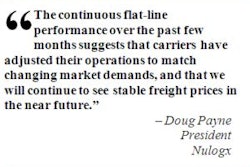
The following article was provided by Julie Murphree, formerly editor-in-chief for Supply & Demand Chain Executive, and currently with the Arizona Farm Bureau. Murphree grew up on a cotton farm in Maricopa, Arizona, and has deep roots in the agricultural supply chain. More information on the Arizona Farm Bureau at www.azfb.org.
Around the breakfast table before the sun's rise, one Midwest farmer explains why even the simplest of technology advances kept him in agriculture. "Without the enclosed cab on tractors, I may not have followed my father into farming. Growing up I froze in winter when driving the tractor and melted in the summer. But that single, simple change on farm equipment made me think I could stick this out."
Throughout history scientific and technological advances have greatly aided agriculture. Simple, incremental improvements in crop production can be traced to the first uses of the humble hoe in ancient times. Today, farmers and other actors in the food supply chain are responding to market pressures, government regulations and increased consumer awareness by collaborating to take advantage of new technologies to better manage agricultural resources and ensure food safety from field to table. For retailers, distributors and, ultimately, end consumers, it is important to understand how this collaboration works, and how technologies come to be adopted in agriculture, to the benefit of the entire food supply chain.
A History of Progress
In the past, gleaning new information was straightforward: Advances in crop and livestock production spread by word of mouth. As new ideas were tried out and applied to growing crops and livestock, they were shared and passed to the next generation. Neighboring tribes even exchanged ideas with one another and with new settlers.
In more recent history, our nation's urgency to focus on the teaching of agriculture, science and engineering as our country grew drove the establishment of land-grant universities designated by each state to receive the benefits of the Morrill Acts of 1862 and 1890, which allowed for funding agriculture research. For the first time, scientists studying at these universities could devote their lives to research and development of agriculture products and practices for livestock and crop production. It paved the way for a revolution in critical advances in agriculture. Advances that have led to nutritiously and economically feeding more people.
But taking the newly developed methods and technology discovered in these institutions beyond the four walls required the Hatch Act of 1887 and the Smith-Lever Act of 1914. The Hatch Act provided federal funds to states to establish a series of agricultural experiment stations under the direction of each state's land-grant institution, as well as pass along new information. The outreach mission was further expanded and extended by the Smith-Lever Act to include cooperative extension — the sending of agents into rural areas to help bring the results of agricultural research to the end users, the producers.
The evolution of this synergistic relationship between the scientist, the agriculturalist and the extension agent has meant that agriculture has benefited and contributed to the ever-evolving science of agriculture. More importantly, it's meant Americans and the world have access to safe, healthy, abundant and economical food.
It all leads us back to today and what agriculturalists and the food supply chain must continue to expect to ensure ongoing success. The scientist, agriculturalist and agent become the critical starting point.
Now More than Ever Let's Commit to the Science
While we're planning our own food budget at the dinner table before grocery shopping, it might also occur to us that more and more mouths around the world need to be fed. According to a recent report from the United Nations, the world needs a 70 percent increase in food production by 2050.
A tighter agricultural supply-demand balance in the future, rising food prices and the increasing role of agriculture commodities in meeting energy needs are all challenges emphasized during a recent presentation to the American Seed Trade Association (ASTA).
Dr. Gale Buchanan, dean and director emeritus for the University of Georgia's College of Agricultural and Environmental Sciences, called attention to the finite resources available for production agriculture such as land, water, petroleum and fertilizer. The growing population, expectations for better living standards and the addition of animal protein to the diet are just a few things that are the impetus for change. One billion people in poor countries rarely get enough to eat, he pointed out. But when they do rise out of abject poverty, they want to add to their diets.
This translates to more demands made on the global agriculture industry.
"The future success of agriculture depends on production improvements," said Buchanan who presented an issue paper on behalf of the Council for Agricultural Science and Technology (CAST) at ASTA's 49th annual Vegetable and Flower Seed Conference. "We've got to take what we've got and make it better."
The paper "Agricultural Productivity Strategies for the Future: Addressing U.S. and Global Challenges" was recently released by CAST and is an update to the first paper published by CAST in 1973, written by geneticist and Nobel Peace Prize winner Dr. Norman Borlaug. This paper, one of the last papers Borlaug contributed to, is available online at http://www.cast-science.org.
"The solutions or means of addressing these challenges must come from increased productivity, because there is not a lot of available land to bring into production," Buchanan explained.
Buchanan discussed the global economy and explained how everything is connected and nothing is isolated — from policies and the environment, to infrastructure and supply and demand. Every country must seek to optimize its infrastructure to improve production.
"There must be a greater commitment for sustained support of research," Buchanan said. "We need to work with others around the world on these issues critical to our sustainability."
Others in the research and development arena understand this, too. "I have seen growers going through extremely difficult times due to changes in labor availability," says Pedro Andrade-Sánchez, precision agriculture specialist, assistant professor with the Agricultural & Biosystems Engineering Department for the Maricopa Agriculture Center (Big MAC), University of Arizona (Arizona's land-grant university). "Moreover, we have seen in the last 10 years a trend of increasing cost of energy-intensive farm inputs. At the same time we have seen great technological developments made commercially available and being adopted at high rates."
Andrade-Sánchez goes on to say: "With overall production costs increasing at rates much higher than the prices of agricultural commodities, the current economic context of farming is not as good as it used to be. Yet our farming systems are highly advanced technologically compared with other countries. That to me indicates that we have to intensify our problem-solving skills, get the best of our engineering innovation in order to increase the efficiency of our resource utilization. We need to improve in order to be competitive in the global context and keep our farming systems healthy, profitable and sustainable. New technology such as precision agriculture (PA) will help us get to this level."
Here for two years at Big MAC, Andrade-Sánchez and a team are in the thick of several projects working with local growers to test, research and develop precision agriculture technology with the aim to reduce costs and increase production for a hungry and growing world.
The Scientist, the Farmer and the Extension Agent
The way modern-apostles of the food movement tell it, some might conclude today's agriculture is evil and lacking in rational science and research-based practices. That's simply not the case. And, the relationships between scientists, farmers and extension agents prove it, producing scientific improvements that have been ongoing now for more than 100 years
Says Andrade-Sánchez: "Our role as applied researchers is to test the limits of new commercially-available technology in solving real problems of farmers. But that's not the end; we need constant interaction with growers to determine if off-the-shelf options do not satisfy their needs; in such cases, we have to do our own research and development of technology. No matter what, we've got to listen to their needs and combine the resources to get the job done."
He and others explain that our modern farmers continue to produce more food crops on less land and are looking to science to help them continue to increase yields per acre but also reduce costs. For example, American farmers' crop yields in the late 1930s averaged from 25 to 40 bushels per harvested acre. Today, American farmers produce corn yields well over 150 bushels per acre.
Arizona cotton, grains and alfalfa farmer Karl Button — a grower partner with Andrade-Sánchez's team — explains the importance of the research/farmer partnership. "Working with growers helps researchers focus and direct their attention to real-world and real-field situations. They can understand the farmer's challenges by partnering with us. It's a two-way deal. I benefit and they benefit."
The technology area of precision agriculture, for example, may require a carefully orchestrated partnership because of its history. Precision agriculture started as a new paradigm in the Midwest states approximately 15 years ago. As a result, precision agriculture is pretty well developed in that region of the country with commercial dealers, contractors and researchers; all combined to provide PA-related services to farmers. In the Southwest, the semi-arid environment is vastly different. Generally speaking, desert lands have a low level of variability. But in response to the high-cost challenges that Arizona farmers are facing, the University of Arizona is in the early phases of helping bring Arizona agriculture to higher levels of precision agriculture technology.
Says Button: "It's not that Arizona was late to the PA ballgame, we just wanted to wait to see it at the World Series. Now, the game is worth going to because Arizona farmers can get as much benefit out of it as Midwest farmers."
When asked about what part of the relationship with the farmer in research helps the most, Andrade-Sánchez had a quick answer. "The willingness to let us use some of their fields and understand their production systems and management practices is a huge help. That way we can try different things to make incremental improvements on technology. A grower's openness to let us work on possible solutions right in their own environment has tremendous value. I am aware of the fact they are in business to be successful, and I want to be sensitive to this truth."
This same commitment to working together with farmers is being repeated all over the country. Every state has a land-grant university, and every land-grant university is specializing in certain areas of agriculture research and development based on that state's agriculture production potential. The diversity of agriculture in America makes the research throughout the country as diverse and varied.
The Agent and Farmer
This feeling of mutual benefit and partnership extends to the cooperative extension arena. Says specialty-crop grower John Boelts with Boelts Farms in Yuma, Arizona: "Our Yuma extension team has saved us a tremendous amount of money in production costs. Additionally, they respond quickly and if something new emerges, like a new pest problem, they take the bull by the horns and spread the word providing information we can use to combat the problem."
In the early stages of extension work, agents often connected with the most influential producer in a given community and introduced that producer to the new technology or improved management techniques knowing that if the technology worked word would quickly spread. Today, it's a combination of interactions including agents that have served a given area for several years and are as well-known and connected as the area farmers.
"That's the kind of approach we've been using here [in Yuma] for 100 years," says Kurt Nolte, area agriculture agent for Yuma County.
Agents and producers also point out that more and more technology and management practice improvements are grassroots. In other words, the improvement is driven by the agriculturalist and pushed back up the research and development chain to the university.
No better example can be found than the one in Yuma relating to food safety. Current turn-around time for lab tests on water quality and other areas is 24 to 48 hours. During the peak of planting and harvest and in an intense market, this time frame is just not fast enough. "Producers want food safety information within minutes," says Nolte.
So, Yuma producers came to Nolte and his team requesting better turn-around times on their lab tests. "We're working hand-in-hand and shoulder-to-shoulder with local producers to develop a device using molecular biology technology to get test results in minutes," says Nolte. "Producers want their water quality sample today!"
While the handheld device is in pilot, the Yuma Cooperative Service team believes it will be a regularly used technology in the future. "It's a win-win for everyone," says Nolte. "The agents learn about the producers' challenges. Producers obtain the research and development perspective and we all advance the research and technology for food safety which is so critical right now."
Again, this is a typical experience around the country as extension agents in other states work with agriculturalists to make technology improvements.
For The Future...
The other links in the agriculture supply chain have taken note of this successful partnership between scientists, agriculturalists and extension agents for some time.
One interesting example involves an exotic plant called guayule (pronounced why-YOU-lee), the University of Arizona, agriculturalists willing to grow this emerging crop and a company called Yulex.
Guayule is a plant indigenous to the Southwestern United States that produces a high-value natural rubber extracted from the bark that can produce latex. For those in the medical profession allergic to synthetic latex, guayule is a blessing.
To bring it to market and provide a product option, U. of A. scientists, agriculturalists and extension agents are working together to make it happen.
Says Andrade-Sánchez, "The more that scientists work with growers, the better we will be at the end. The constant interaction of growers gives us the ability to understand what is relevant. The best way is to work with them on their farms. Their world is the world I want to impact."
And while farmer Button has committed to partnering with U. of A. researchers for the last 15 years, he says one of the strongest benefits in working with them is the accumulated knowledge gleaned from the partnership. "Advances in machinery, herbicides, monitoring techniques, crop management techniques and biotechnology all contributes to the industry's ongoing successes in modern production agriculture."
Ultimately, without the three-way relationship of the scientist, agriculturalist and agent, today's agriculture would not be able to accommodate a growing population while at the same time providing healthy and economical food.
Yes, three guys walked into a test plot, and the process let them change the world for the better. It's certainly food for thought.
Around the breakfast table before the sun's rise, one Midwest farmer explains why even the simplest of technology advances kept him in agriculture. "Without the enclosed cab on tractors, I may not have followed my father into farming. Growing up I froze in winter when driving the tractor and melted in the summer. But that single, simple change on farm equipment made me think I could stick this out."
Throughout history scientific and technological advances have greatly aided agriculture. Simple, incremental improvements in crop production can be traced to the first uses of the humble hoe in ancient times. Today, farmers and other actors in the food supply chain are responding to market pressures, government regulations and increased consumer awareness by collaborating to take advantage of new technologies to better manage agricultural resources and ensure food safety from field to table. For retailers, distributors and, ultimately, end consumers, it is important to understand how this collaboration works, and how technologies come to be adopted in agriculture, to the benefit of the entire food supply chain.
A History of Progress
In the past, gleaning new information was straightforward: Advances in crop and livestock production spread by word of mouth. As new ideas were tried out and applied to growing crops and livestock, they were shared and passed to the next generation. Neighboring tribes even exchanged ideas with one another and with new settlers.
In more recent history, our nation's urgency to focus on the teaching of agriculture, science and engineering as our country grew drove the establishment of land-grant universities designated by each state to receive the benefits of the Morrill Acts of 1862 and 1890, which allowed for funding agriculture research. For the first time, scientists studying at these universities could devote their lives to research and development of agriculture products and practices for livestock and crop production. It paved the way for a revolution in critical advances in agriculture. Advances that have led to nutritiously and economically feeding more people.
But taking the newly developed methods and technology discovered in these institutions beyond the four walls required the Hatch Act of 1887 and the Smith-Lever Act of 1914. The Hatch Act provided federal funds to states to establish a series of agricultural experiment stations under the direction of each state's land-grant institution, as well as pass along new information. The outreach mission was further expanded and extended by the Smith-Lever Act to include cooperative extension — the sending of agents into rural areas to help bring the results of agricultural research to the end users, the producers.
The evolution of this synergistic relationship between the scientist, the agriculturalist and the extension agent has meant that agriculture has benefited and contributed to the ever-evolving science of agriculture. More importantly, it's meant Americans and the world have access to safe, healthy, abundant and economical food.
It all leads us back to today and what agriculturalists and the food supply chain must continue to expect to ensure ongoing success. The scientist, agriculturalist and agent become the critical starting point.
Now More than Ever Let's Commit to the Science
While we're planning our own food budget at the dinner table before grocery shopping, it might also occur to us that more and more mouths around the world need to be fed. According to a recent report from the United Nations, the world needs a 70 percent increase in food production by 2050.
A tighter agricultural supply-demand balance in the future, rising food prices and the increasing role of agriculture commodities in meeting energy needs are all challenges emphasized during a recent presentation to the American Seed Trade Association (ASTA).
Dr. Gale Buchanan, dean and director emeritus for the University of Georgia's College of Agricultural and Environmental Sciences, called attention to the finite resources available for production agriculture such as land, water, petroleum and fertilizer. The growing population, expectations for better living standards and the addition of animal protein to the diet are just a few things that are the impetus for change. One billion people in poor countries rarely get enough to eat, he pointed out. But when they do rise out of abject poverty, they want to add to their diets.
This translates to more demands made on the global agriculture industry.
"The future success of agriculture depends on production improvements," said Buchanan who presented an issue paper on behalf of the Council for Agricultural Science and Technology (CAST) at ASTA's 49th annual Vegetable and Flower Seed Conference. "We've got to take what we've got and make it better."
The paper "Agricultural Productivity Strategies for the Future: Addressing U.S. and Global Challenges" was recently released by CAST and is an update to the first paper published by CAST in 1973, written by geneticist and Nobel Peace Prize winner Dr. Norman Borlaug. This paper, one of the last papers Borlaug contributed to, is available online at http://www.cast-science.org.
"The solutions or means of addressing these challenges must come from increased productivity, because there is not a lot of available land to bring into production," Buchanan explained.
Buchanan discussed the global economy and explained how everything is connected and nothing is isolated — from policies and the environment, to infrastructure and supply and demand. Every country must seek to optimize its infrastructure to improve production.
"There must be a greater commitment for sustained support of research," Buchanan said. "We need to work with others around the world on these issues critical to our sustainability."
Others in the research and development arena understand this, too. "I have seen growers going through extremely difficult times due to changes in labor availability," says Pedro Andrade-Sánchez, precision agriculture specialist, assistant professor with the Agricultural & Biosystems Engineering Department for the Maricopa Agriculture Center (Big MAC), University of Arizona (Arizona's land-grant university). "Moreover, we have seen in the last 10 years a trend of increasing cost of energy-intensive farm inputs. At the same time we have seen great technological developments made commercially available and being adopted at high rates."
Andrade-Sánchez goes on to say: "With overall production costs increasing at rates much higher than the prices of agricultural commodities, the current economic context of farming is not as good as it used to be. Yet our farming systems are highly advanced technologically compared with other countries. That to me indicates that we have to intensify our problem-solving skills, get the best of our engineering innovation in order to increase the efficiency of our resource utilization. We need to improve in order to be competitive in the global context and keep our farming systems healthy, profitable and sustainable. New technology such as precision agriculture (PA) will help us get to this level."
Here for two years at Big MAC, Andrade-Sánchez and a team are in the thick of several projects working with local growers to test, research and develop precision agriculture technology with the aim to reduce costs and increase production for a hungry and growing world.
The Scientist, the Farmer and the Extension Agent
The way modern-apostles of the food movement tell it, some might conclude today's agriculture is evil and lacking in rational science and research-based practices. That's simply not the case. And, the relationships between scientists, farmers and extension agents prove it, producing scientific improvements that have been ongoing now for more than 100 years
Says Andrade-Sánchez: "Our role as applied researchers is to test the limits of new commercially-available technology in solving real problems of farmers. But that's not the end; we need constant interaction with growers to determine if off-the-shelf options do not satisfy their needs; in such cases, we have to do our own research and development of technology. No matter what, we've got to listen to their needs and combine the resources to get the job done."
He and others explain that our modern farmers continue to produce more food crops on less land and are looking to science to help them continue to increase yields per acre but also reduce costs. For example, American farmers' crop yields in the late 1930s averaged from 25 to 40 bushels per harvested acre. Today, American farmers produce corn yields well over 150 bushels per acre.
Arizona cotton, grains and alfalfa farmer Karl Button — a grower partner with Andrade-Sánchez's team — explains the importance of the research/farmer partnership. "Working with growers helps researchers focus and direct their attention to real-world and real-field situations. They can understand the farmer's challenges by partnering with us. It's a two-way deal. I benefit and they benefit."
The technology area of precision agriculture, for example, may require a carefully orchestrated partnership because of its history. Precision agriculture started as a new paradigm in the Midwest states approximately 15 years ago. As a result, precision agriculture is pretty well developed in that region of the country with commercial dealers, contractors and researchers; all combined to provide PA-related services to farmers. In the Southwest, the semi-arid environment is vastly different. Generally speaking, desert lands have a low level of variability. But in response to the high-cost challenges that Arizona farmers are facing, the University of Arizona is in the early phases of helping bring Arizona agriculture to higher levels of precision agriculture technology.
Says Button: "It's not that Arizona was late to the PA ballgame, we just wanted to wait to see it at the World Series. Now, the game is worth going to because Arizona farmers can get as much benefit out of it as Midwest farmers."
When asked about what part of the relationship with the farmer in research helps the most, Andrade-Sánchez had a quick answer. "The willingness to let us use some of their fields and understand their production systems and management practices is a huge help. That way we can try different things to make incremental improvements on technology. A grower's openness to let us work on possible solutions right in their own environment has tremendous value. I am aware of the fact they are in business to be successful, and I want to be sensitive to this truth."
This same commitment to working together with farmers is being repeated all over the country. Every state has a land-grant university, and every land-grant university is specializing in certain areas of agriculture research and development based on that state's agriculture production potential. The diversity of agriculture in America makes the research throughout the country as diverse and varied.
The Agent and Farmer
This feeling of mutual benefit and partnership extends to the cooperative extension arena. Says specialty-crop grower John Boelts with Boelts Farms in Yuma, Arizona: "Our Yuma extension team has saved us a tremendous amount of money in production costs. Additionally, they respond quickly and if something new emerges, like a new pest problem, they take the bull by the horns and spread the word providing information we can use to combat the problem."
In the early stages of extension work, agents often connected with the most influential producer in a given community and introduced that producer to the new technology or improved management techniques knowing that if the technology worked word would quickly spread. Today, it's a combination of interactions including agents that have served a given area for several years and are as well-known and connected as the area farmers.
"That's the kind of approach we've been using here [in Yuma] for 100 years," says Kurt Nolte, area agriculture agent for Yuma County.
Agents and producers also point out that more and more technology and management practice improvements are grassroots. In other words, the improvement is driven by the agriculturalist and pushed back up the research and development chain to the university.
No better example can be found than the one in Yuma relating to food safety. Current turn-around time for lab tests on water quality and other areas is 24 to 48 hours. During the peak of planting and harvest and in an intense market, this time frame is just not fast enough. "Producers want food safety information within minutes," says Nolte.
So, Yuma producers came to Nolte and his team requesting better turn-around times on their lab tests. "We're working hand-in-hand and shoulder-to-shoulder with local producers to develop a device using molecular biology technology to get test results in minutes," says Nolte. "Producers want their water quality sample today!"
While the handheld device is in pilot, the Yuma Cooperative Service team believes it will be a regularly used technology in the future. "It's a win-win for everyone," says Nolte. "The agents learn about the producers' challenges. Producers obtain the research and development perspective and we all advance the research and technology for food safety which is so critical right now."
Again, this is a typical experience around the country as extension agents in other states work with agriculturalists to make technology improvements.
For The Future...
The other links in the agriculture supply chain have taken note of this successful partnership between scientists, agriculturalists and extension agents for some time.
One interesting example involves an exotic plant called guayule (pronounced why-YOU-lee), the University of Arizona, agriculturalists willing to grow this emerging crop and a company called Yulex.
Guayule is a plant indigenous to the Southwestern United States that produces a high-value natural rubber extracted from the bark that can produce latex. For those in the medical profession allergic to synthetic latex, guayule is a blessing.
To bring it to market and provide a product option, U. of A. scientists, agriculturalists and extension agents are working together to make it happen.
Says Andrade-Sánchez, "The more that scientists work with growers, the better we will be at the end. The constant interaction of growers gives us the ability to understand what is relevant. The best way is to work with them on their farms. Their world is the world I want to impact."
And while farmer Button has committed to partnering with U. of A. researchers for the last 15 years, he says one of the strongest benefits in working with them is the accumulated knowledge gleaned from the partnership. "Advances in machinery, herbicides, monitoring techniques, crop management techniques and biotechnology all contributes to the industry's ongoing successes in modern production agriculture."
Ultimately, without the three-way relationship of the scientist, agriculturalist and agent, today's agriculture would not be able to accommodate a growing population while at the same time providing healthy and economical food.
Yes, three guys walked into a test plot, and the process let them change the world for the better. It's certainly food for thought.

















